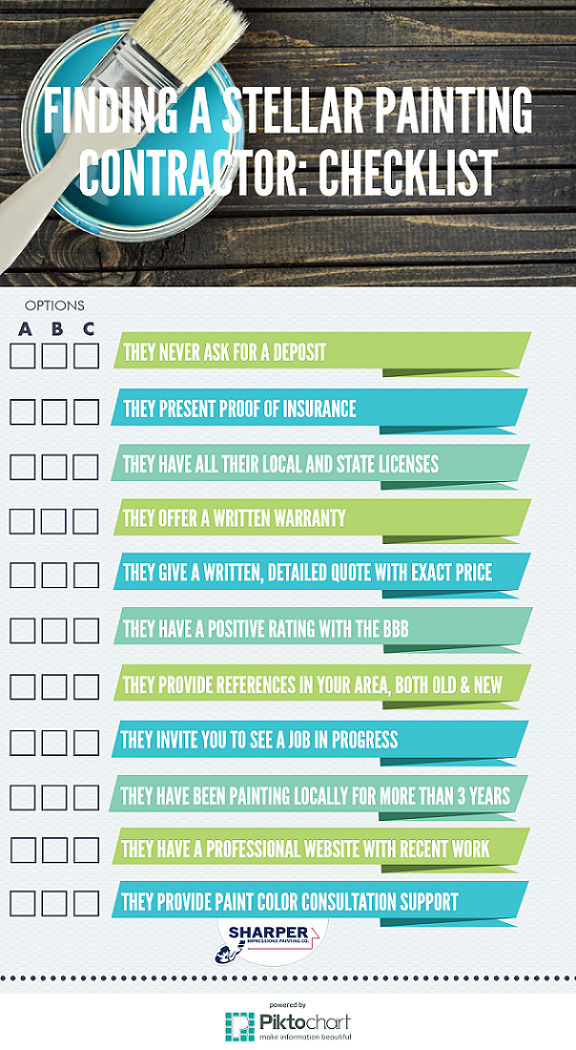Detailed Refine For Getting Your Wall Surfaces Ready For A Fresh Layer Of Paint
Detailed Refine For Getting Your Wall Surfaces Ready For A Fresh Layer Of Paint
Blog Article
Posted By-Binderup Bland
When you're prepping your walls for paint, it's critical to follow a methodical procedure to ensure a flawless finish. Beginning by checking out the wall surface for any damages; this step can make or break your job. Once you have actually determined any kind of problems, cleaning up the surface appropriately is essential, as an unclean wall surface can influence paint attachment. Afterwards, you'll require to spot any type of blemishes and use a guide. Yet there specify methods and ideas that can elevate your prep work video game-- let's check out those more to achieve the most effective results.
Assessing Wall Surface Problem
Prior to you order your paintbrush, take a moment to examine your wall surfaces' condition. Check for any visible damage like splits, holes, or peeling paint. These flaws can impact just how the paint sticks and looks as soon as it's completely dry. If garage painting services discover any substantial damages, you'll need to focus on fixings before diving into painting.
Look very closely at the structure of your walls. Is the surface smooth, or exists structure that might require special consideration? Smooth walls generally call for less prep, while distinctive surface areas might need even more time to repaint evenly.
Likewise, consider the previous paint work. If the old paint is glossy, it mightn't permit new paint to stick appropriately. You'll need to know if your walls have been painted with oil-based or water-based paint, as this can affect your choice of guide or paint.
Ultimately, take note of any type of moisture concerns. If you see indicators of water damage or mold and mildew, address these problems right away to avoid further complications.
Cleaning up the Surface area
As soon as you have actually analyzed the problem of your wall surfaces, the following step is cleansing the surface. Start by collecting your materials: a container, warm water, a light detergent, a sponge or fabric, and a scrub brush for tougher places.
Begin on top edge of the wall and function your means down. Mix the cleaning agent with warm water in your bucket, after that dip the sponge or towel into the solution. Wring it out to prevent too much wetness on the walls.
As you clean, pay close attention to locations that could've gathered dust, grease, or fingerprints. For persistent spots, make use of the scrub brush carefully to avoid harming the paint below. Rinse 2 guys painting or cloth often in clean water to stop spreading out dust around.
After cleaning, it's vital to wipe the walls with a moist cloth to eliminate any type of soap deposit. This action ensures a smooth surface for the new paint to stick to.
Permit the walls to completely dry entirely before proceeding to the following prep work actions. This extensive cleaning procedure will help develop a fresh canvas for your paint job, ensuring the very best results.
Patching and Priming
Patching and priming are essential steps in preparing your wall surfaces for a fresh coat of paint. Initially, inspect your wall surfaces for any type of openings, splits, or imperfections. Utilize a top quality spackling substance or patching paste to fill these areas.
Apply the compound with a putty blade, smoothing it out so it's flush with the surrounding surface. Enable https://www.washingtonpost.com/home/2023/03/22/diy-paint-projects/ to completely dry entirely, and after that sand it gently till it's smooth and also.
As soon as you have actually covered everything, it's time to prime. Primer helps seal the covered locations, making sure the paint adheres appropriately and offers an uniform surface. Pick a primer suitable for your wall surface type and the paint you'll be utilizing.
Use the guide using a roller for bigger locations and a brush for corners and edges. If your patched areas are dramatically large or permeable, you could intend to apply a second layer of guide after the very first one dries out.
After priming, let every little thing dry completely before proceeding to painting. This prep work will not just improve the appearance of your walls yet additionally prolong the life of your paint work.
Take your time, and you'll be pleased with the outcomes.
Verdict
By following these basic actions, you can accomplish a smooth and specialist surface on your wall surfaces. Begin by evaluating their condition, after that tidy and spot any type of blemishes prior to using primer. Bear in mind to enable ample drying time and make certain everything is smooth before you dive into paint. With the right preparation, you'll set the stage for a gorgeous transformation in your area. Currently, collect your products, breathe in the fresh air, and prepare yourself to paint!
